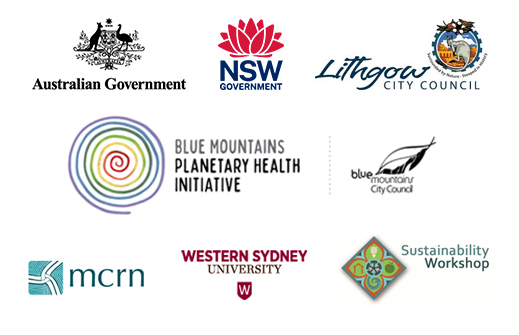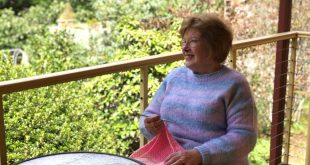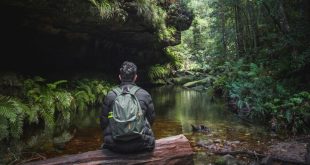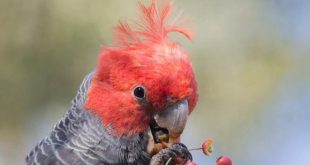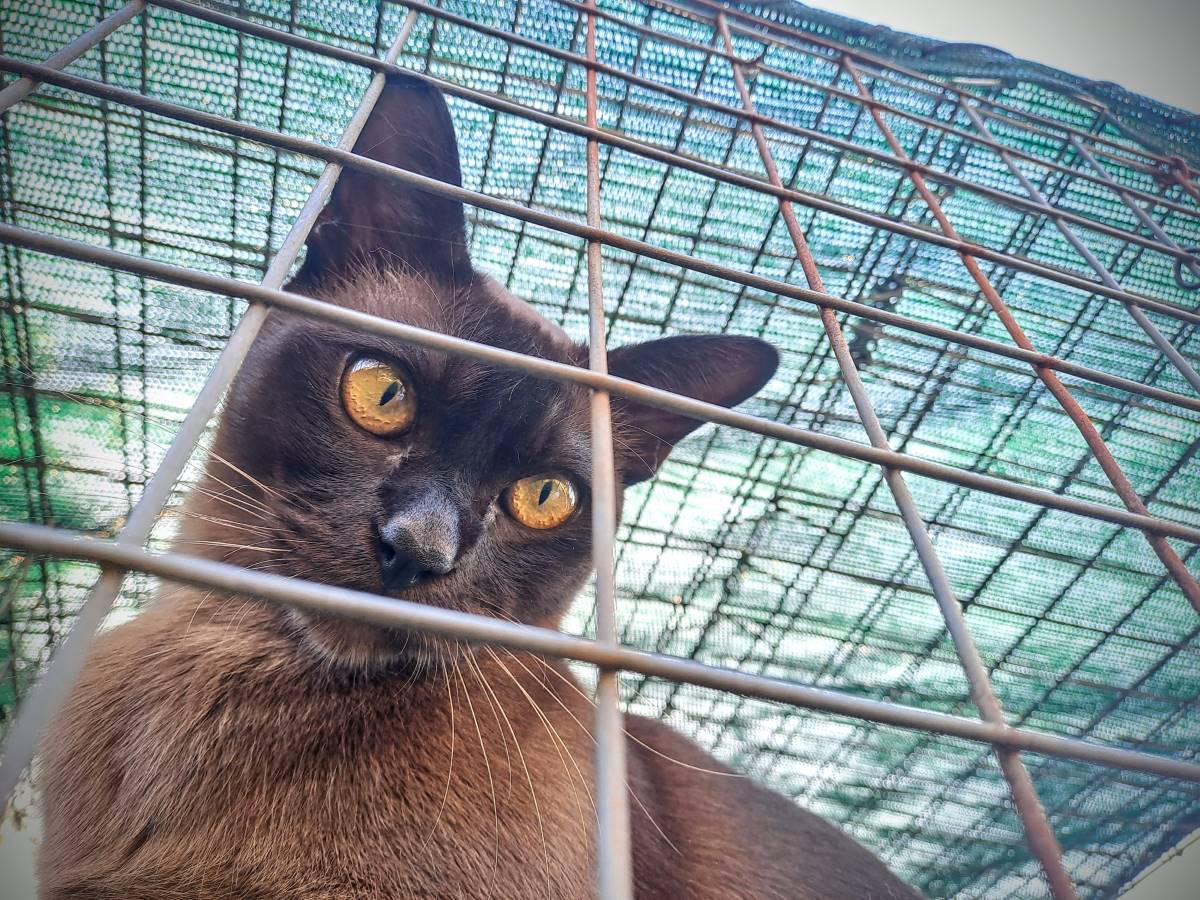
Cat enclosures keep cats and wildlife safe. Lawson cat ‘Bas’ enjoys a high perch in his outdoor enclosure.
Story and photos by Belle Butler
While feral cats are considered one of the worst invasive species in Australia, free-roaming domestic cats are collectively responsible for the deaths of 323 million native animals each year. Belle Butler attended a talk hosted by Blue Mountains Conservation Society and Blue Mountains Bird Observers with guest speaker and former conservation officer from the Invasive Species Council, Candice Bartlett, about the impact of cats on our local wildlife and practical solutions and actions needed to keep cats and wildlife safe.
Key Points:
- Feral and domestic cats kill large numbers of native animals
- The debate about cat ownership and containment has been emotive and divisive
- A recent event in the Blue Mountains highlighted some potential solutions
Cats.
Did the word trigger a reaction in you? For many Blue Mountains residents this topic spawns a passionate response, one way or another. In my own circles I’ve known it to be a bomb of a conversation starter, no-go territory at dinner-parties, and the cause of neighbourly disputes.
This is for good reason, because while cats hold a lot of value for their human caretakers by providing companionship, lap cuddles and the odd excuse for a good laugh, they are also responsible for significant carnage in our wildlife populations. In Australia, feral cats are a leading contributor to at least 20 extinctions and, according to The Invasive Species Council, they take out fourth place in Australia’s top ten worst invasive species.
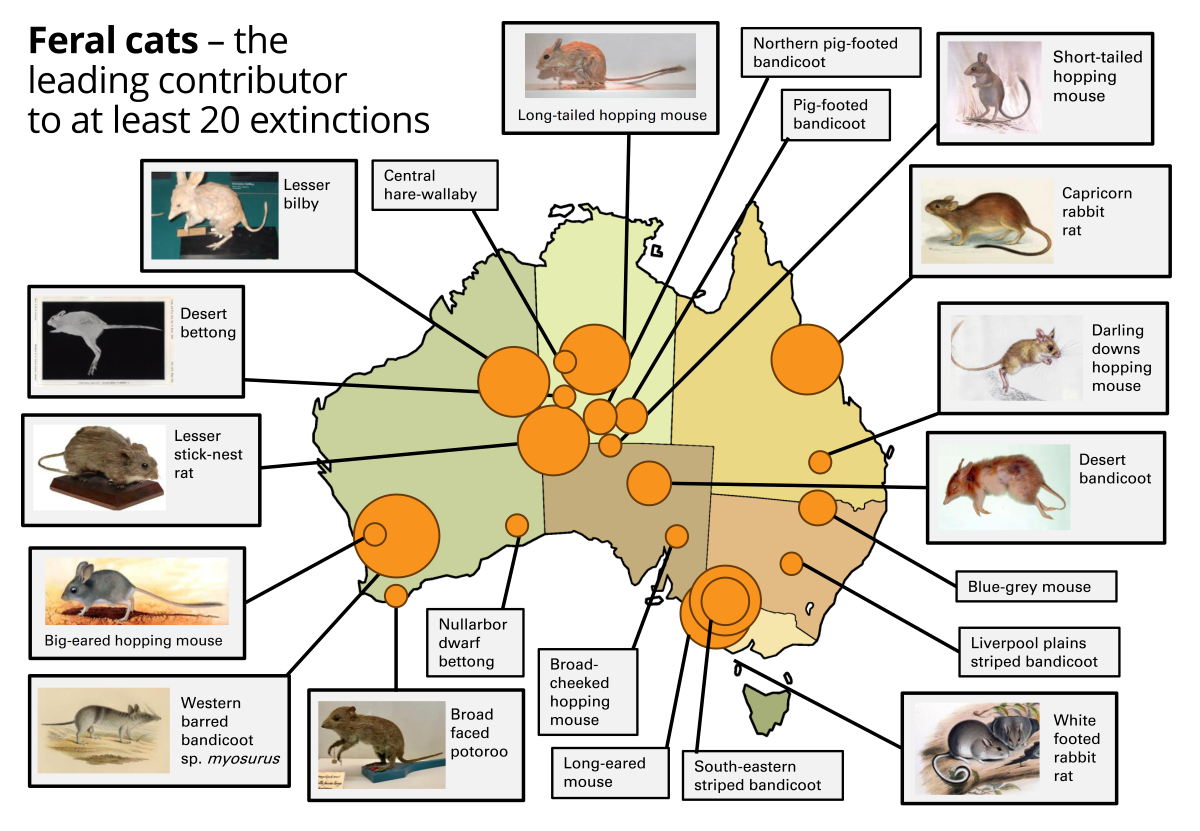
Image courtesy of Candice Bartlett
But what of that sweet little fur-ball cosying up at the end of your bed? A domestic cat that is allowed to roam kills about 186 animals per year, 60% of which are native. Collectively and annually, this amounts to the deaths of 323 million native animals.
At a recent joint event held by Blue Mountains Conservation Society and Blue Mountains Bird Observers at the Mid Mountains Neighbourhood Centre in Lawson, invited speaker and former conservation officer Candice Bartlett from The Invasive Species Council, addressed the ‘cat-problem’ in the Blue Mountains by re-posing it as a ‘people problem’: “How do we shift people’s hearts and minds to keep cats safe for everyone?” she asked, in a carefully considered question that aims to make a cause for change without starting a war.
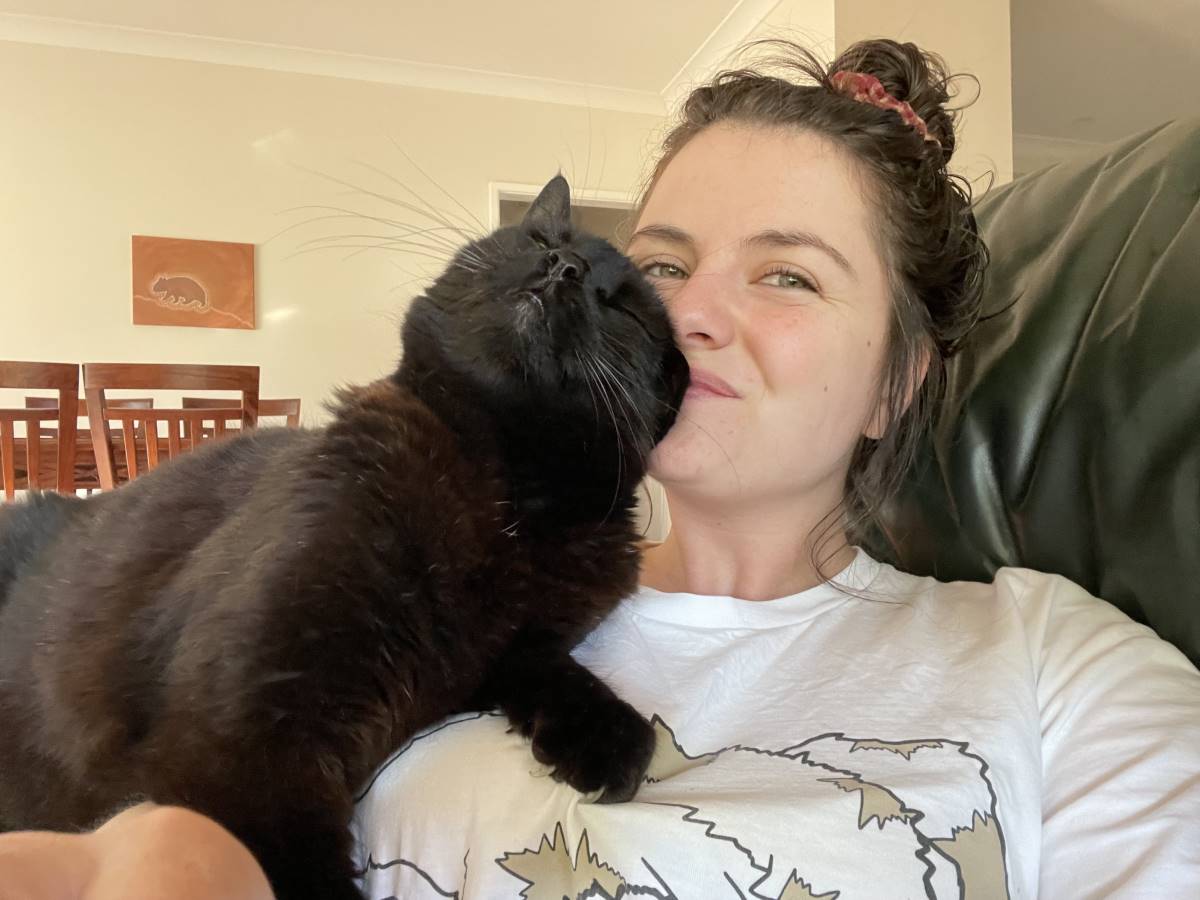
Former Conservation Officer, Candice Bartlett, from The Invasive Species Council with her indoor cat, Fat Boii.
Candice, a cat owner (or ‘cat-slave,’ as she calls herself), spoke to a full hall of Blue Mountains residents about the need for change in how we keep cats, in order to reduce the negative impact they have on our local wildlife, as well as for their own welfare (contained cats live an average of 10 years longer than free-roaming cats).
“At least 455 different native animal species have been recorded in the Blue Mountains Local Government Area, including frogs, mammals, lizards and birds,” she said. “Cats will prey upon any of these animals. It’s really important to ensure cats aren’t roaming and hunting in the Blue Mountains to help protect the unique diversity and number of native wildlife we live with.”
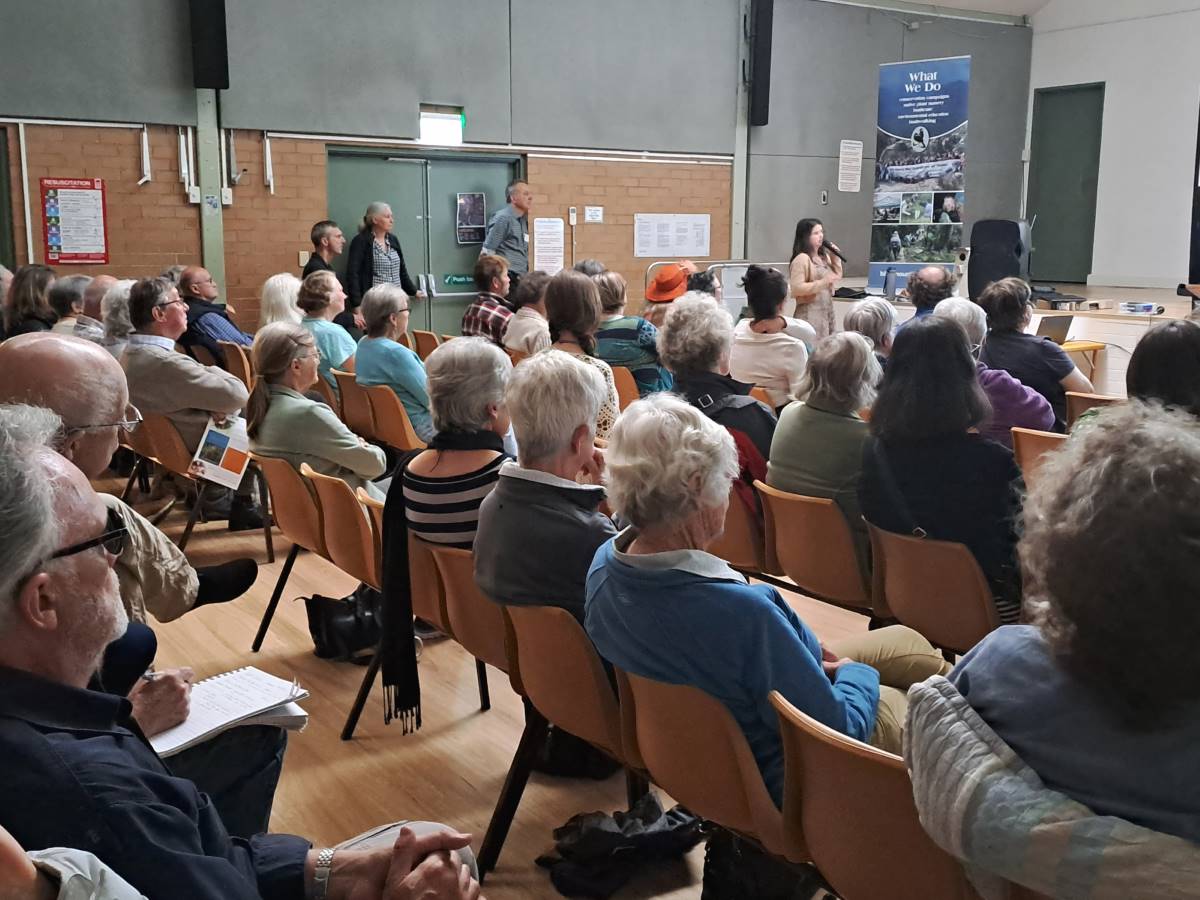
Candice speaking to a full hall of Blue Mountains residents keen for change.
Cat Problems
The facts:
- Cats now live across 99.9% of Australia. (The only places they don’t live are on islands where they have been successfully eradicated, such as Dirk Hartog Island, which was declared cat-free in 2018. Native species have now been successfully reintroduced on the island.)
- National cat population:
- 5.3 million pet cats
- 1.4 – 5.6 million feral cats
- 0.7 million unowned or semi-owned cats in urban area
- Cats are obligate carnivores (they need meat).
- Hunting is part of a cat’s natural behaviour and they are super hunters. They can see clearly in low light and can jump up to six times their height.
- Australian wildlife did not evolve with cats.
- 50%-70% of Australian cat owners allow their cats to roam freely.
- When allowed to roam, cats will act on instinct and hunt, regardless of how well fed they are.
- Average home range of a free-roaming pet cat is 2 hectares (40 house blocks).
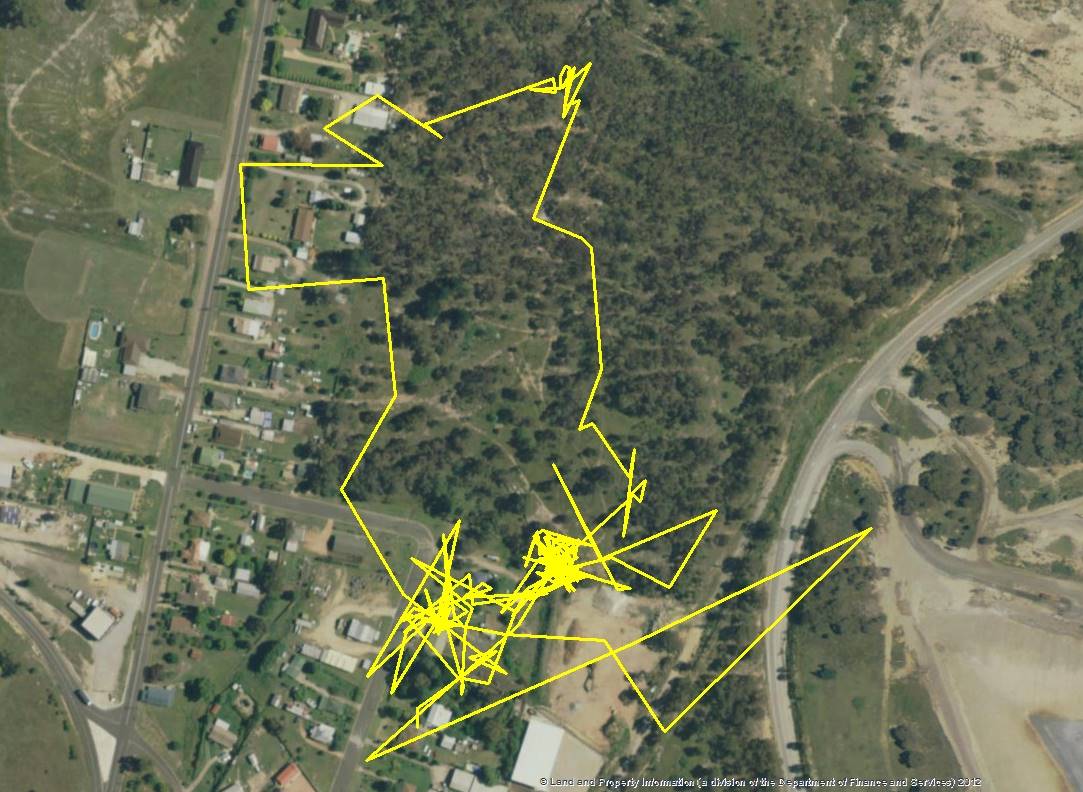
Cat tracking program in Lithgow shows the movement of a pet cat. Map By Central Tablelands Land Services.
- Cats leave most of their prey where they catch it – as little as 15% of prey is brought home.
- An average roaming pet cat kills 186 animals per year – 60% are native (n = 110). That’s 323 million native animals killed by pet cats each year.
- The presence and scent of cats (and dogs) can alter wildlife behaviour.
- Two in three cat owners have lost a cat to a roaming related incident.
- Cats can contract and spread toxoplasmosis.
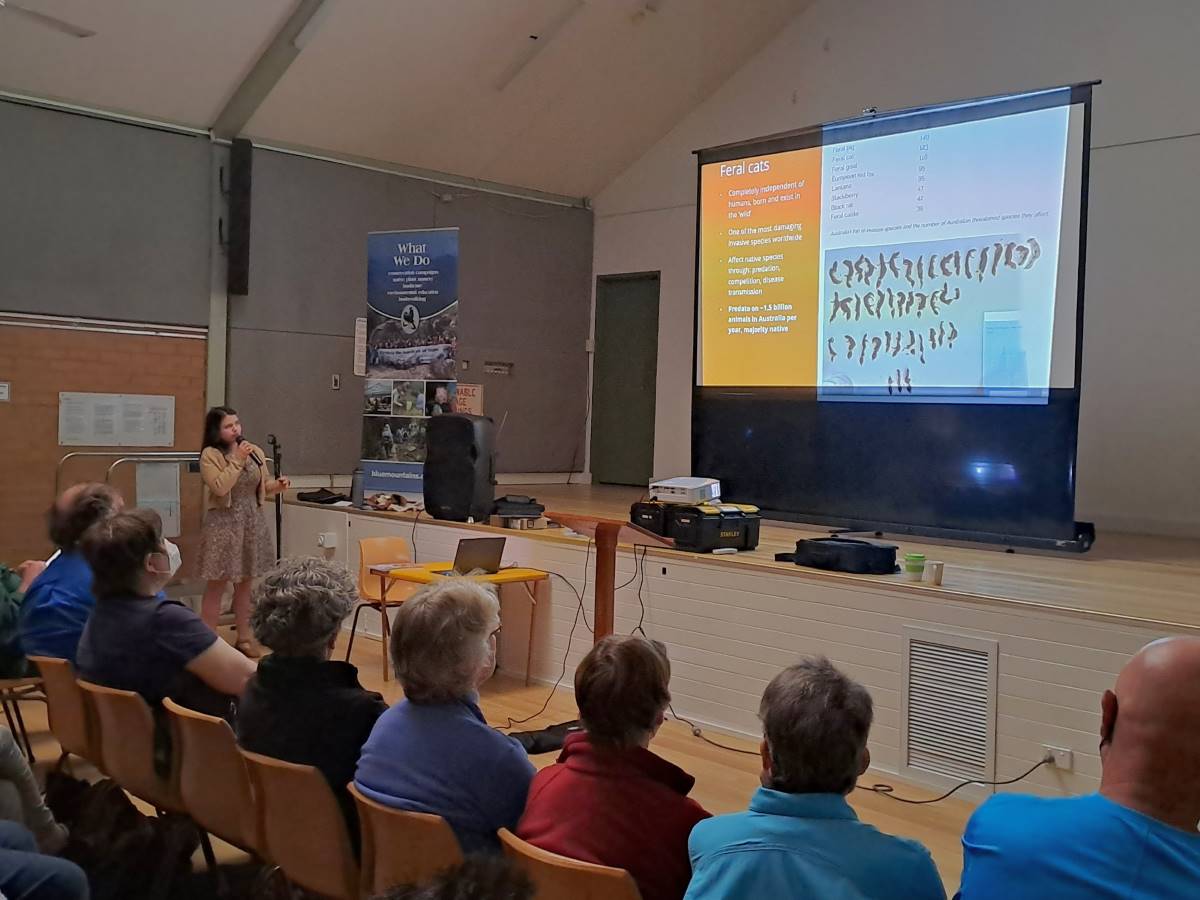
Candice discussing the impact of feral cats in Australia.
Potential Solutions
“Over time I hope that one of the first questions people ask themselves before getting a cat is: ‘Do I have the right space to prevent my cat from escaping my house/yard?’ This is already a default question for people considering getting a dog,” said Candice.
“To get there we need to normalise keeping cats contained. For me, this requires ongoing two-way conversations that help people understand the benefits of cat containment, but also recognises everyone has a different starting point along the journey to 24/7 cat containment. We need strong enabling legislation that requires owners to keep their pet cats on their property, as well as continued support and education.”
Six states and territories in Australia have given power to local councils to introduce their own locally-specific cat curfews and containment rules (NSW and WA are the remaining states to do so). This has had a significant impact on how people view and practice cat ownership as well as ongoing positive impacts on the local environment in those areas. (Read about Bruny Island’s experience of establishing cat containment by-laws here).
In the Blue Mountains, awareness is on the rise, as is support for amending the NSW Companion Animals Act 1998 to allow councils to implement cat containment measures that meet local needs.
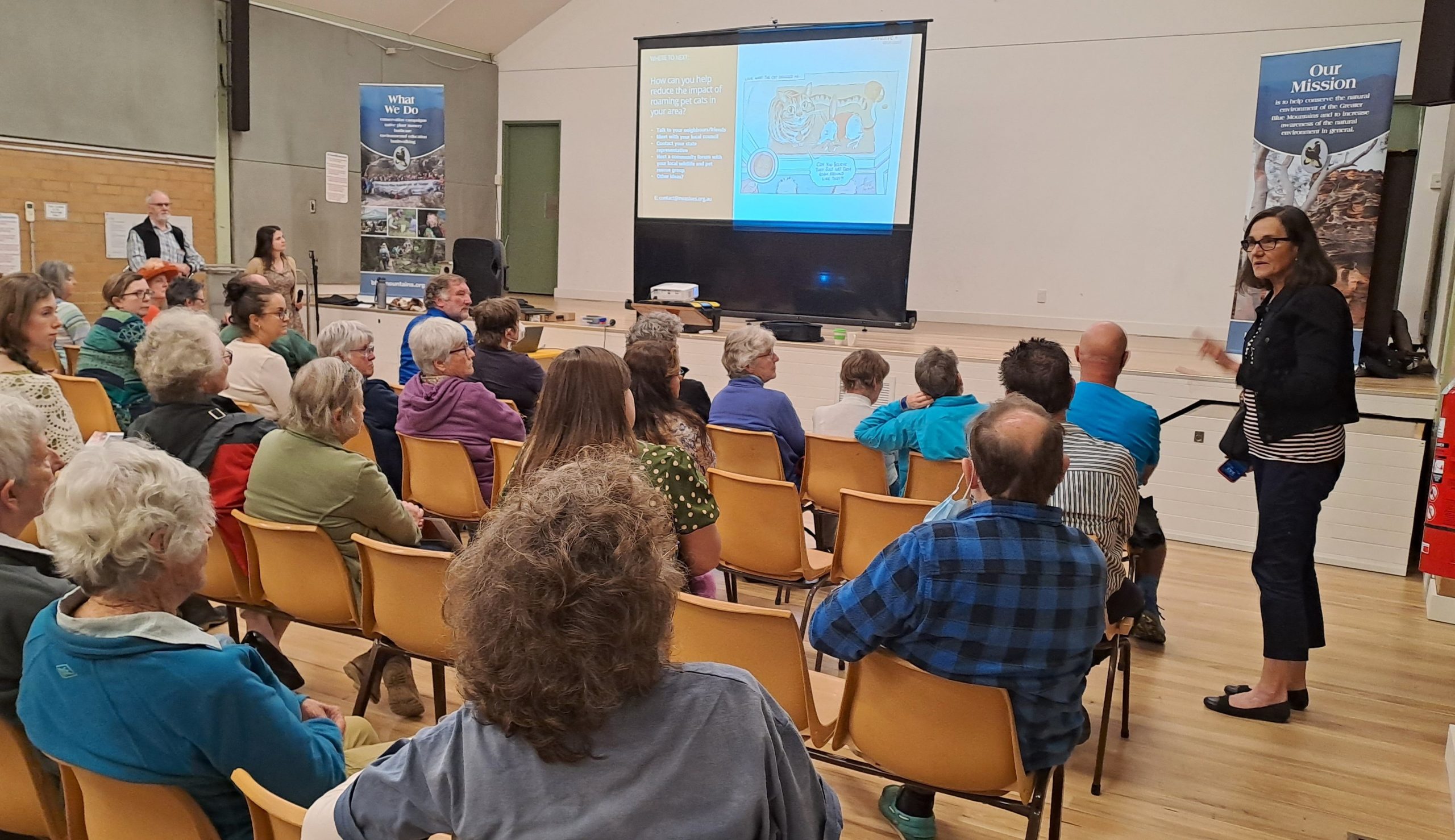
Cr Romola Hollywood addressing the audience about Blue Mountains City Council’s strong support for reform around cat policy.
Councillor Romola Hollywood, who attended the event in Lawson, said: “Council has a very strong position on supporting a change of the NSW Government’s Act. We understand the NSW Government will be holding an inquiry into the Companion Animals Act. Councils would also need to be resourced to implement cat containment measures should it become possible by law to do so in NSW in the future.”
Councillors Brent Hoare and Sarah Redshaw echoed this sentiment, pointing out that four councillors from Blue Mountains City Council attended the talk (Cr Claire West was also in attendance): “So we are very intent on sorting this problem out,” Sarah said. (Council’s responsible cat ownership fact sheet can be found here.)
In partnership with the RSPCA, Council is participating in the NSW Government’s Keeping Cats Safe at Home Program from 2021 to 2025, which encourages Blue Mountains cat owners to keep their cats safely enclosed at home. As part of the program, Council is currently offering cat owners the chance to win one of 32 Cat Enclosure Prize Packs valued at $500 each.
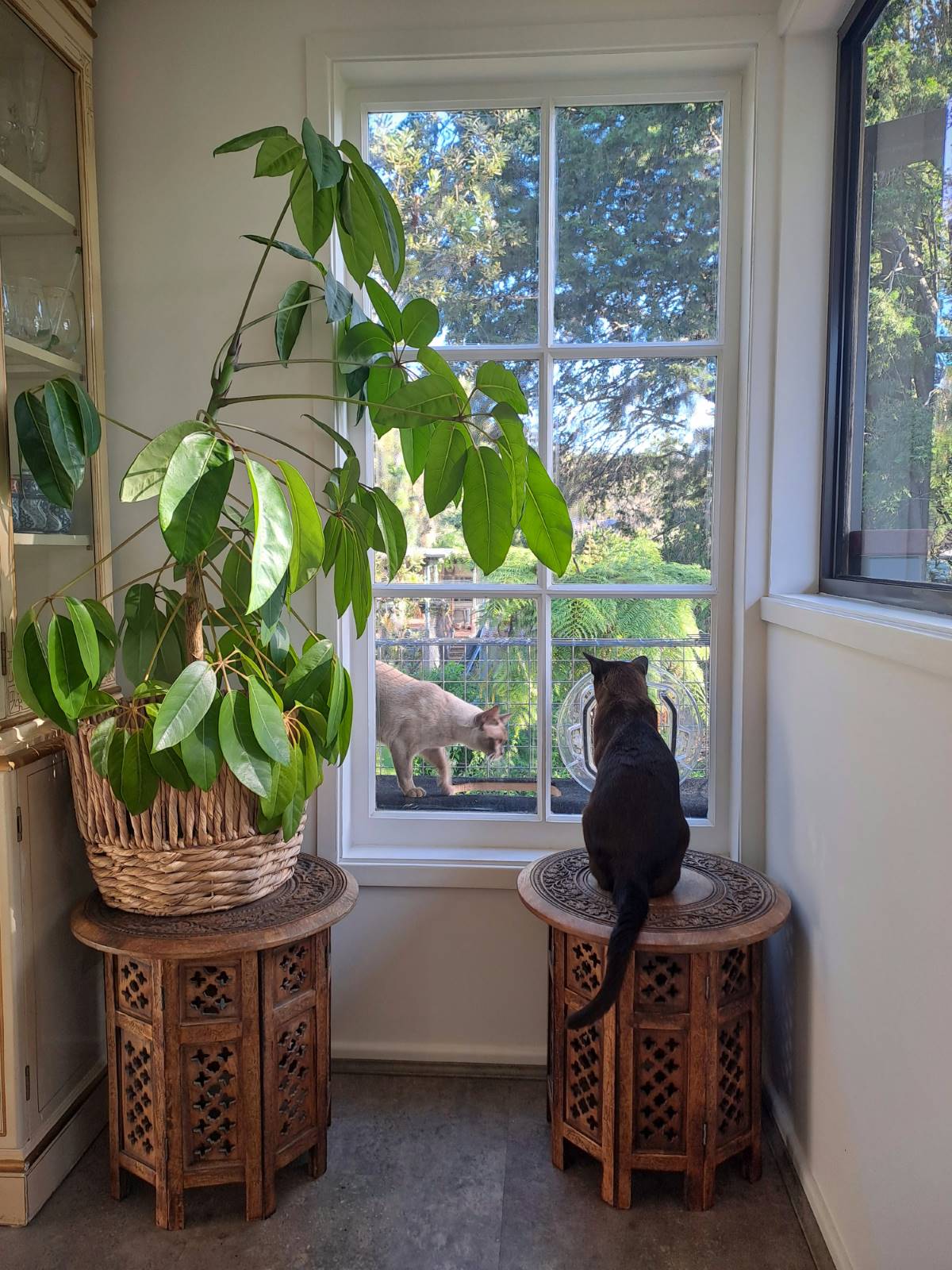
Contained cats Bas and Maureen access their securely enclosed outdoor spaces as they please via purpose-built window flaps.
Although NSW remains one of two states yet to implement laws to enable cat containment, more and more Blue Mountains residents are taking the initiative to shift their own behaviour.
When my new neighbours recently moved in, they sheepishly confessed to us and other residents on the street that they owned two cats. They immediately followed this admission up with a declaration about their love of local wildlife and their awareness about the impact of cats in the area.
Given the regular visible carnage of birdlife and small mammals on our street due to roaming cats, as well as resulting neighbourly disputes in the past, I was most impressed by the open approach of my new neighbours. I was even more impressed when they went ahead and built a cat enclosure in their backyard in order to keep their beloved pets safe while protecting the local wildlife (and our chickens!).
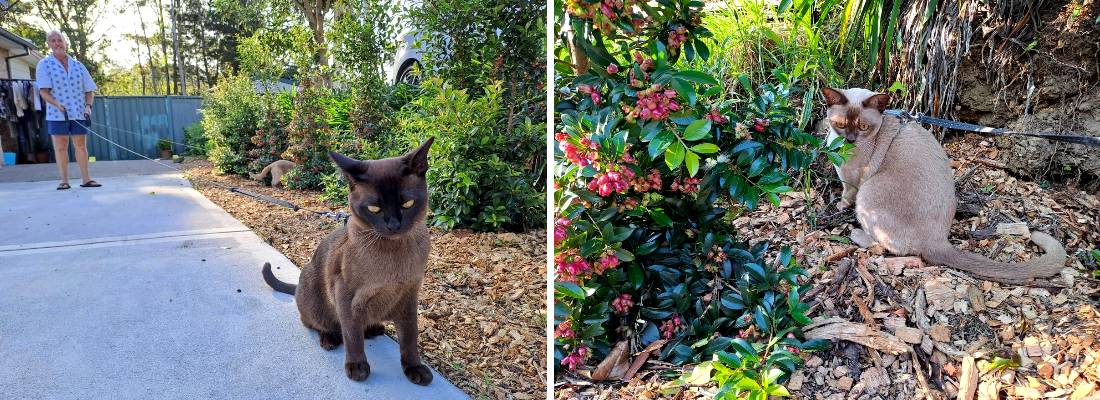
Lawson resident Simon with his on-leash cats Bas and Maureen.
Two other cat owners in the area, Simon Strasiotto and Jiri Teringer, are regularly spotted taking ‘Bas’ and ‘Maureen’ for on-leash walks. “We kept them indoors until they were 3 months old,” Simon informed me. “Then we saw that they had noticed the outdoors and their instincts really kicked in, so we decided we needed to take measures. Cats are apex killers, so you can’t let them out without restraints.”
The self-evidently dedicated and adoring ‘cat dads’ spent a lot of time getting Bas and Maureen used to wearing harnesses while indoors, so that they would be physically comfortable and not associate their leads with a bad experience. “Now they love the leash,” Simon said. The cats are treated to 20 minute – 1 hour walks twice a day.
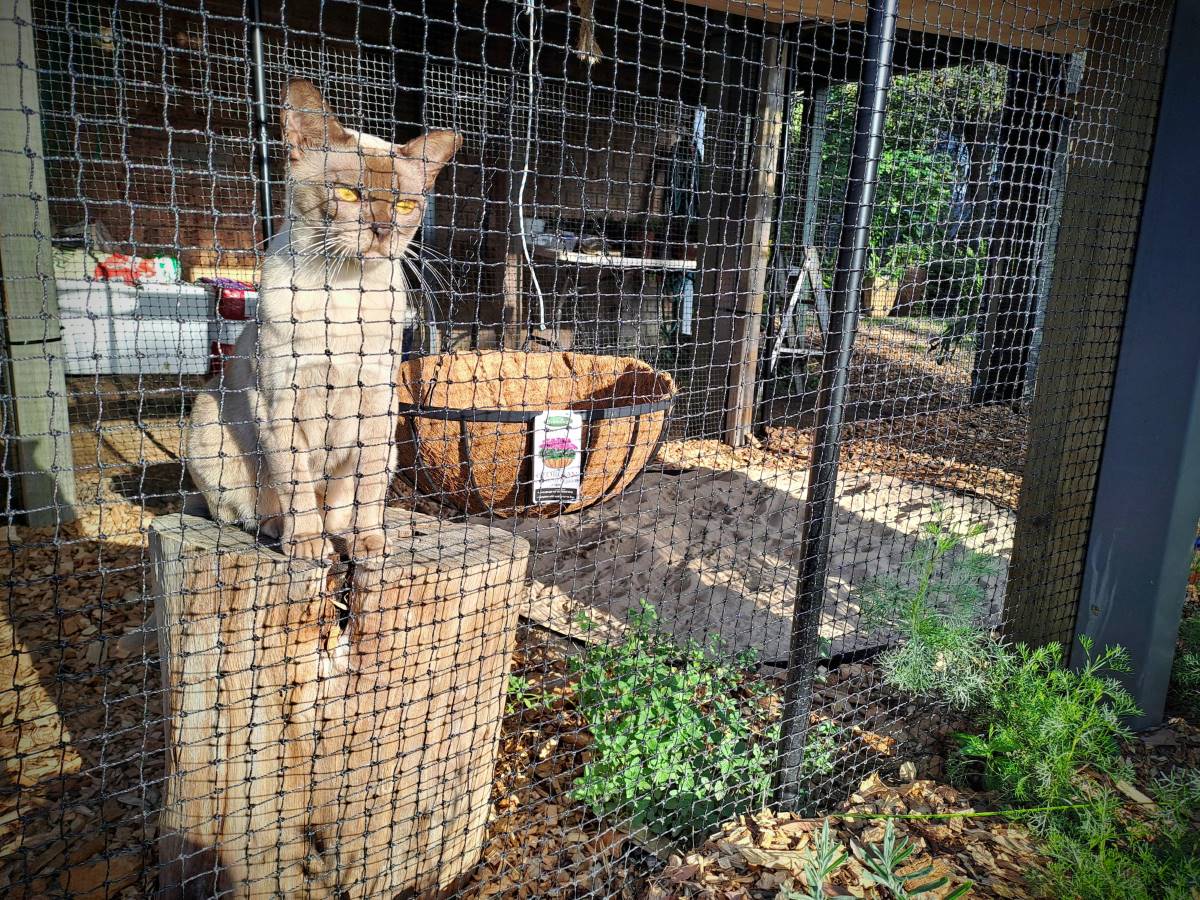
Maureen listening to the birds from the safety of her ‘catio’.
Simon and Jiri also built two impressive cat enclosures – the ‘catio’ under their back deck and ‘cat towers’ out the front – both connected via purpose-built flap doors so that Bas and Maureen can come and go as they please, any time of the day or night, while staying safe and not impacting the local wildlife.
“The main thing for us is giving our cats engagement and enrichment opportunities while keeping them and wildlife safe. And the result is two well-balanced, socialised happy cats that have as rich a life as you can give them.”
Take Action:
- Appeal to the NSW State Government to amend the NSW Companion Animals Act 1998 to allow councils to implement cat containment measures that meet local needs.
- Consider owning pets that don’t kill the local wildlife. Or, if you already own a cat or decide to get one in the future, make sure to prevent your cat from roaming by building a cat enclosure and/or taking your cat for supervised walks.
- Open-up a friendly discussion with your neighbours about collectively shifting our views and behaviours when it comes to responsible ownership of cats in the Blue Mountains.
Resources & further reading:
- Factsheet on cat-proof fencing – Cat Protection Society
- Blue Mountains City Council Companion Animals Management Plan 2021 to 2025
- Blue Mountains City Council Guide to Keeping Cats Safe
- RSPCA Keeping Cats Safe
- RSPCA How to Talk to Your Neighbour About Their Cat
- RSPCA Transitioning to The Safe-At-Home Lifestyle
- RSPCA What Your Cat Needs at Home
- RSPCA Enrichment Help Your Cat Live Their Best Life at Home
- Invasive Species Council – Pet Cat Impacts
- Low-hanging fruit: Pet cat containment a vital step to protect NSW’s wildlife – Nature Conservation Council of NSW
Share this article:
Suppliers of free standing enclosures:
- Catnets | Cat Enclosures, Cat nets, Cat Netting, Cat Runs, Containment
- Cat Enclosures – Catnip Australia – Quality Australian Made Cat Enclosures
- www.secureakat.com.au/cat-cube/
- www.catmax.com.au/product-category/catmax-caboodles/
- www.sydneycatenclosures.com.au/enclosures
This story has been produced as part of a Bioregional Collaboration for Planetary Health and is supported by the Disaster Risk Reduction Fund (DRRF). The DRRF is jointly funded by the Australian and New South Wales governments.
